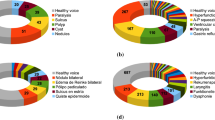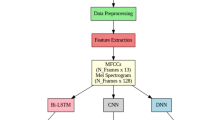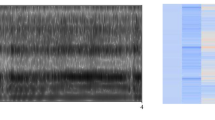Abstract
Voice problems influence numerous people these days, if any of their internal organs are infected. Voice pathologies may affect people who are elderly, frequently allergic, addicted to tobacco as well as singers, speakers, teachers and so on. Diagnosing those disorders at the earliest ahead of examining by specialists reduces the expensive treatment cost. Acoustic analysis plays a major part in identifying voice disorders. Examination techniques in recognizing voice pathologies can be intertwined with deep learning strategies to identify the voice pathology automatically and to accurately distinguish people who are healthy from people who are suffering with voice pathology. The fundamental purpose of this paper is to accomplish an initial study that elucidates the possibilities of using classification models in case of pathological voice recognition. Experiments were conducted using classifiers, and their performance metrics were evaluated. The result analysis shows that MLP performs well with 98% accuracy compared to other classifiers.
Access this chapter
Tax calculation will be finalised at checkout
Purchases are for personal use only
Similar content being viewed by others
References
Sztahó D, Gábor K, Gábriel TM (2021) Deep learning solution for pathological voice detection using LSTM-based autoencoder hybrid with multi-task learning. In: BIOSIGNALS 2021—14th international conference on bio-inspired systems and signal processing; part of the 14th international joint conference on biomedical engineering systems and technologies, BIOSTEC 2021, vol 4 (Biostec), pp 135–141. https://doi.org/10.5220/0010193101350141
Verde L, De Pietro G, Sannino G (2018) Voice disorder identification by using machine learning techniques. IEEE Access 6:16246–16255. https://doi.org/10.1109/ACCESS.2018.2816338
Moon J, Kim S (2018) An approach on a combination of higher-order statistics and higher-order differential energy operator for detecting pathological voice with machine learning. In: 9th international conference on information and communication technology convergence: ICT convergence powered by smart intelligence, ICTC March, pp 46–51. https://doi.org/10.1109/ICTC.2018.8539495
Borovikova DV, Makukha VK, Shevchenko TA (2018) Comparative analysis of acoustic parameters of the Saarbruecken database’s voice records. In: 2018 19th international conference of young specialists on micro/nanotechnologies and electron devices (EDM), pp 6403–6406. https://doi.org/10.1109/EDM.2018.8435044
Ezzine K, Frikha M (2018) Investigation of glottal flow parameters for voice pathology detection on SVD and MEEI databases. In: 4th international conference on advanced technologies for signal and image processing (ATSIP), pp 1–6
Fang SH, Tsao Y, Hsiao MJ, Chen JY, Lai YH, Lin FC, Wang CT (2018) Detection of pathological voice using cepstrum vectors: a deep learning approach. J Voice
Harar P, Alonso-Hernandezy JB, Mekyska J, Galaz Z, Burget R, Smekal Z (2017) Voice pathology detection using deep learning: a preliminary study. In: International conference and workshop on bioinspired intelligence (IWOBI), pp 1–4
Arjmandi MK, Pooyan M, Mikaili M, Vali M, Moqarehzadeh A (2011) Identification of voice disorders using long-time features and support vector machine with different feature reduction methods. J Voice Off J Voice Found 25:275–289
Mesallam TA, Farahat M, Malki KH, Alsulaiman M, Ali Z, Al-nasheri A, Muhammad G (2017) Development of the Arabic voice pathology database and its evaluation by using speech features and machine learning algorithms. J Healthcare Eng 342–351
Firdos S, Umarani K (2016) Disordered voice classification using SVM and feature selection using GA. In: Second international conference on cognitive computing and information processing (CCIP), pp 1–6
Souza TA, Souza MA, Washington CDA, Costa SC, Correia SE, Vieira VJ (2015) Feature selection based on binary particle swarm optimization and neural networks for pathological voice detection. In: Latin America congress on computational intelligence (LA-CCI), pp 1–6
Fezari M, Amara F, El-Emary IM (2014) Acoustic analysis for detection of voice disorders using adaptive features and classifiers. In: Proceedings 2014th international conference on circuits, systems, and control
Saeedi NE, Almasganj F, Torabinejad F (2011) Support vector wavelet adaptation for pathological voice assessment. Comput Biol Med 41(9):822–828
Author information
Authors and Affiliations
Editor information
Editors and Affiliations
Rights and permissions
Copyright information
© 2022 The Author(s), under exclusive license to Springer Nature Singapore Pte Ltd.
About this paper
Cite this paper
Deepa, P., Khilar, R. (2022). Lecture Notes in Computer Science: Pathological Voice Recognition Based on Acoustic Phonatory Features. In: Mohanty, M.N., Das, S. (eds) Advances in Intelligent Computing and Communication. Lecture Notes in Networks and Systems, vol 430. Springer, Singapore. https://doi.org/10.1007/978-981-19-0825-5_9
Download citation
DOI: https://doi.org/10.1007/978-981-19-0825-5_9
Published:
Publisher Name: Springer, Singapore
Print ISBN: 978-981-19-0824-8
Online ISBN: 978-981-19-0825-5
eBook Packages: Intelligent Technologies and RoboticsIntelligent Technologies and Robotics (R0)




